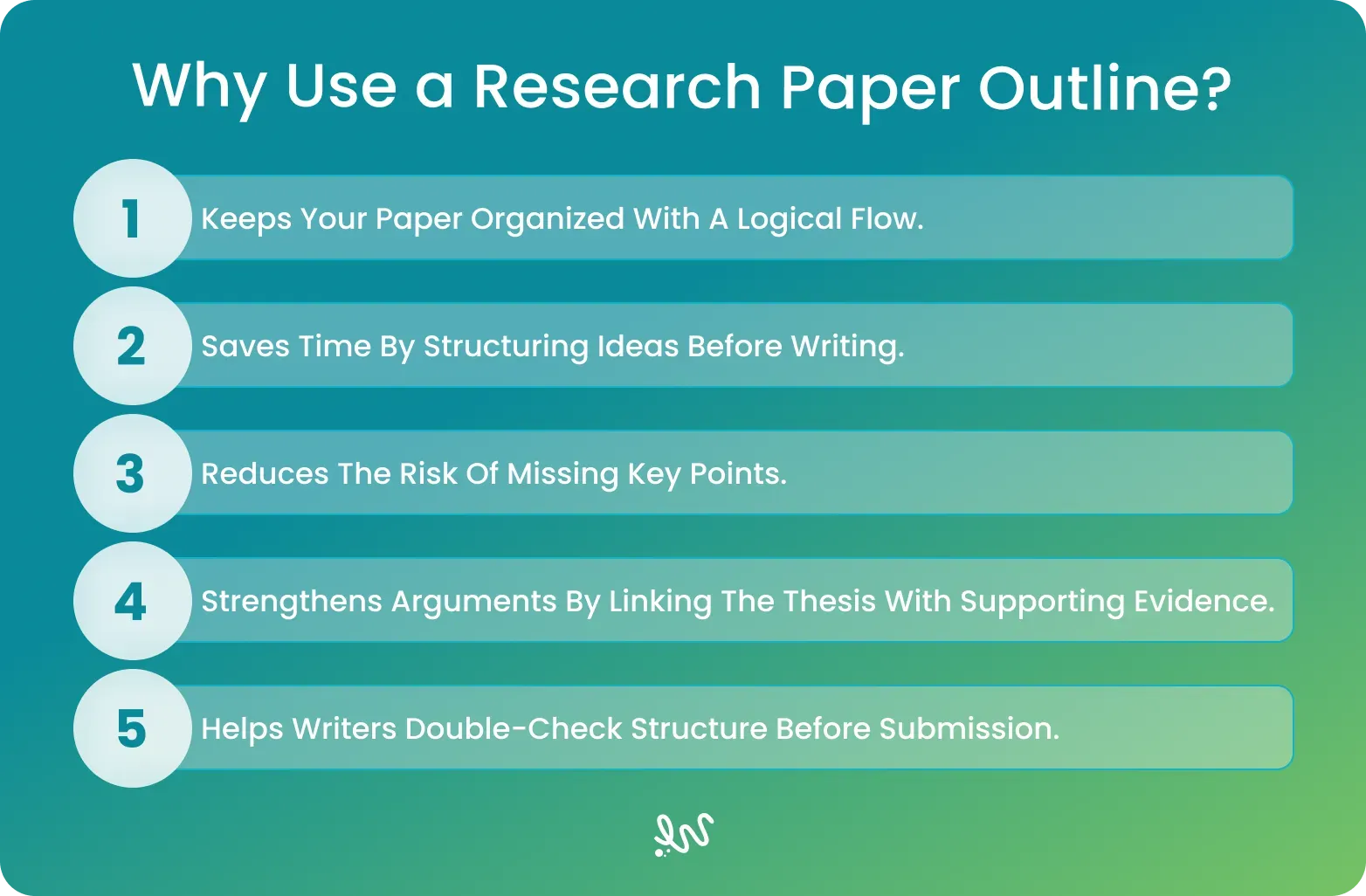The toughest part of a research paper is the scramble to fit scattered notes and half-thoughts into something coherent. A 2018 ResearchGate study found that structured planning significantly increases writing efficiency in student papers. Without a plan, arguments tangle, key points vanish, and what should be a clear essay becomes a scattered draft.
This article breaks down the research paper outline step by step. You’ll see real outline examples, formatting options, language rules, and even free downloadable templates to guide your own writing process.
And if you struggle to create research paper, you don’t have to do it alone. With expert help at hand, you can focus on shaping ideas while WriteMyEssay keeps the process clear.
Stuck on Your Research Paper?
Get guidance on outlines, structure, and writing from start to finish.
Get Help
Benefits of Using a Research Paper Outline
Without an outline, notes scatter, arguments loop, and whole findings slip through the cracks. With one, patterns become visible. You notice when two points overlap or when a gap opens between the background and methodology. In other words, the outline tests ideas against each other in working memory before you commit to pages.

The benefits show up fast:
- Sharper clarity: every section has a defined aim tied to the research question.
- Stronger flow: Roman numerals and indents force ideas into sequence, making the argument easier to follow.
- Fewer gaps: missing evidence or skipped steps reveal themselves early.
- Faster drafting: with the framework built, sentences come quicker and revision shrinks.
Outline Example for Research Paper
To illustrate, here’s an example of an outline for a research paper and how a structure looks when applied to a scientific topic.
Title: Climate Change and Its Impact on Coastal Communities
I. Introduction
- Hook: Sea levels have risen globally by eight inches since 1900 (NOAA).
- Background: Rising temperatures are reshaping coastlines and moving populations.
- Research Question: How are coastal communities adapting to climate threats?
- Thesis Statement: Climate change increases the likelihood of flooding, destruction of infrastructure, and migration, requiring better adaptation policies.
II. Literature Review
- Scientific studies on sea level rise and storm frequency;
- Case studies of vulnerable coastal cities;
- Research on policy responses and urban planning;
- Gaps in existing studies, especially in developing countries.
III. Methodology
- Participants: Interviews with residents and policymakers in three coastal towns;
- Data Collection: Satellite imagery, government reports, community surveys;
- Analysis: Compare adaptation strategies across different regions.
IV. Results/Findings
- Evidence of flooding and erosion in surveyed areas;
- Community costs: economic losses, relocation challenges;
- Policy effectiveness: where adaptation measures worked and where they failed.
V. Discussion
- Implications for infrastructure planning and disaster readiness;
- Social consequences, including displacement and inequality;
- Study limitations and future research directions.
VI. Conclusion
- Restate the thesis with evidence from findings;
- Stress the urgency of adaptive strategies;
- Call to action: highlight the role of global cooperation in protecting vulnerable regions.
VII. References
- Climate reports, peer-reviewed articles, and government data.
Free Research Paper Outline PDF Examples
We’ve put together three complete outlines on different topics. Download free samples and start your research paper outline.
Outline Formats for a Research Paper Outline
Research papers differ, and so do the outlines. There are three main formats you can use while creating a research paper outline:
Alphanumeric Format
This is the most common style. It uses Roman numerals, capital letters, Arabic numerals, and lowercase letters. Many students prefer the Alphanumeric format because it makes connecting main points easier.
Example:
I. Introduction
A. Background of the study
1. Importance of topic
a. Supporting evidence
Full-Sentence Format
In a full-sentence outline format, headings and subheadings are written in complete sentences. When you format research paper this way, it becomes clear and detailed, and it makes sure that every part of your outline supports and links to the thesis.
Example:
I. Climate change policies are shaped by both scientific research and political pressures.
A. Governments increasingly prioritize renewable energy investment to reduce emissions.
Decimal Format
Relies on numbers to show levels of hierarchy, creating a clear and precise structure. Useful for longer, technical papers.
Example:
1.0 Introduction
1.1 Background
1.1.1 Research question
1.1.1.1 Supporting evidence
Types of Language Used in Research Paper Outlines
Choose the right way to outline your research paper. The words you choose shape how clearly your ideas come across. There are four core principles: parallelism, coordination, subordination, and division.
1. Parallelism
Parallelism indicates consistency, specifically in language. Every heading at the same outline level should be parallel (following the same grammatical structure). Without parallelism, outlines are hard to follow. Parallel phrasing also forces you to clarify your ideas, and the lack of matching wording often suggests gaps in logic.
Weak example:
I. Studying effectively
II. Sleep is important
III. Healthy meals boost energy
Stronger example:
I. Developing effective study habits
II. Maintaining regular sleep patterns
III. Choosing healthy meals for energy
2. Coordination
Coordination makes sure that items at the same outline level are equal in weight. If one heading is a broad category, and the other is a specific detail, the outline is unbalanced and, at least logically, confusing. Coordination makes every section stay logically aligned in depth and length.
Unbalanced example:
I. Causes of climate change
A. Greenhouse gases
B. Cutting down trees in the Amazon rainforest that threatens biodiversity
Balanced example:
I. Causes of climate change
A. Greenhouse gas emissions
B. Deforestation
3. Subordination
Subordination implies hierarchy. The main headings should be broad, and the subheadings should be the supporters or details of the broader theme. Your main headings will cover your thesis, and your second level headings will provide support. Not following this hierarchy will lead to repetitive ideas, or worse, a lack of argument supporting your main themes hidden under minor points.
Example:
I. Impact of technology on education
A. Expansion of online learning platforms
1. Increased accessibility for remote students
2. Flexible learning schedules for working adults
4. Division
Division means that every section of your outline must be broken down into at least 2 sections. If a heading has one subheading, it makes the idea either incomplete or misplaced in your outline. This principle also ensures that if your ideas have room for development, you will find the ways to develop them before you start to write research paper.
Incomplete example:
I. Benefits of exercise
A. Physical health
Complete example:
I. Benefits of exercise
A. Physical health
B. Mental health
Key Elements of a Research Paper Outline
Writing an effective research paper outline goes beyond just listing sections. Each element that you include has a specific purpose. Let’s have a look at them:
- Title: Captures the topic. Your working title must reflect the research’s central idea.
- Abstract: Not always applicable. If your paper requires one, it should include a short summary of the study.
- Introduction: Should list three items that will be further explored in the research paper introduction: a hook, background, and a thesis statement.
- Literature review: The outline for this section should map the key studies you plan to discuss.
- Methodology: This part outlines how you’ll explain your research design. Mention approach, sources, and methods.
- Results/findings: Not a full data, but should include main outcomes, trends, or unexpected results.
- Discussion: This section interprets the findings and stops the draft from drifting off course.
- Conclusion: Here you’ll bring the paper full circle. Conclusion includes restated thesis, importance of the findings, and suggestions for future research.
- References: List the key works you’ll cite here.
Research Paper Outline Example PDF with a Template
Now that you have a research paper outline example for students, it’s time for us to give you a ready-to-use and free outline template that you can download and adapt to your topic.
Final Thoughts
By now, you’ve probably already realized how important it is to have a strong outline before you start writing your paper. It’s a tool that helps you catch weak spots in advance and avoid last-minute panic.
Still, planning research paper can feel like a lot. That’s where WME comes in. Whether you need guidance shaping your outline or want expert help to write a research paper for you, we connect you with support that makes the process less stressful.
Research Paper Stress Ends Here
Work with experts who know how to structure, write, and polish academic papers.
Reach Out
FAQ
What Is a Research Paper Outline?
It’s your paper in blueprint form, laying out introduction, body, and conclusion paragraphs before you start writing.
What Are the Three Main Components of a Research Paper Outline?
Every research paper has three main parts: the introduction, where you introduce the thesis, the body paragraphs, and the conclusion, where you finalize your findings.
How Long Should a Research Paper Outline Be?
It’s up to you, but most outlines fit on one to three pages. It should be detailed enough to guide you through writing, but short enough that you can scan it quickly while drafting.
Sources
- San Diego State University. (2025, April). Basic Research Paper Outline (PDF). Retrieved from San Diego State University website: https://interwork.sdsu.edu/sites/default/files/2025-04/Research-Paper-Outline.pdf
- University of Southern California Libraries. (n.d.). Writing guide: Outline. Retrieved from https://libguides.usc.edu/writingguide/outline
- University of Maryland Global Campus. (2025). Planning and writing a research paper: Outline. In Online Guide to Writing and Research. Retrieved from https://www.umgc.edu/current-students/learning-resources/writing-center/online-guide-to-writing/tutorial/chapter4/ch4-18



